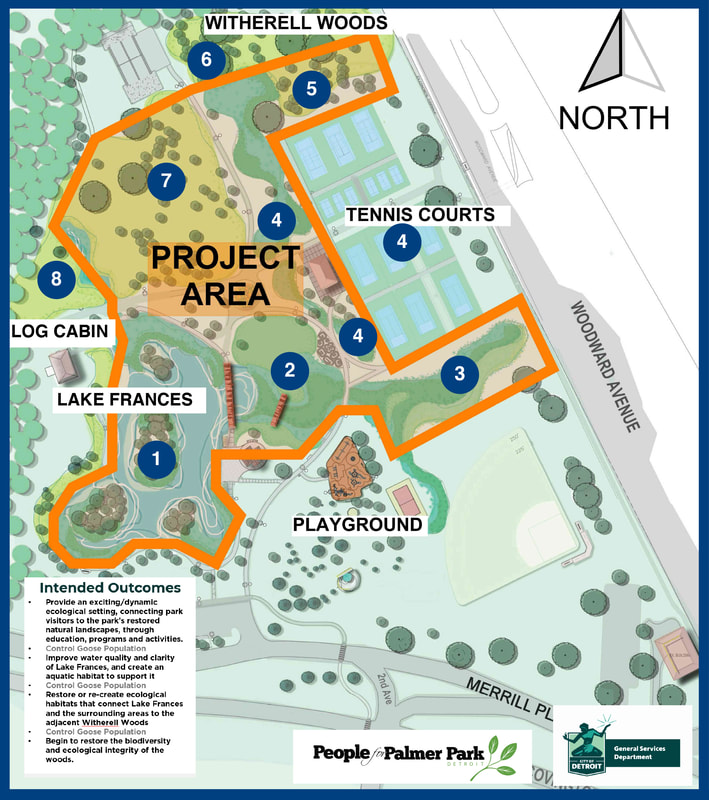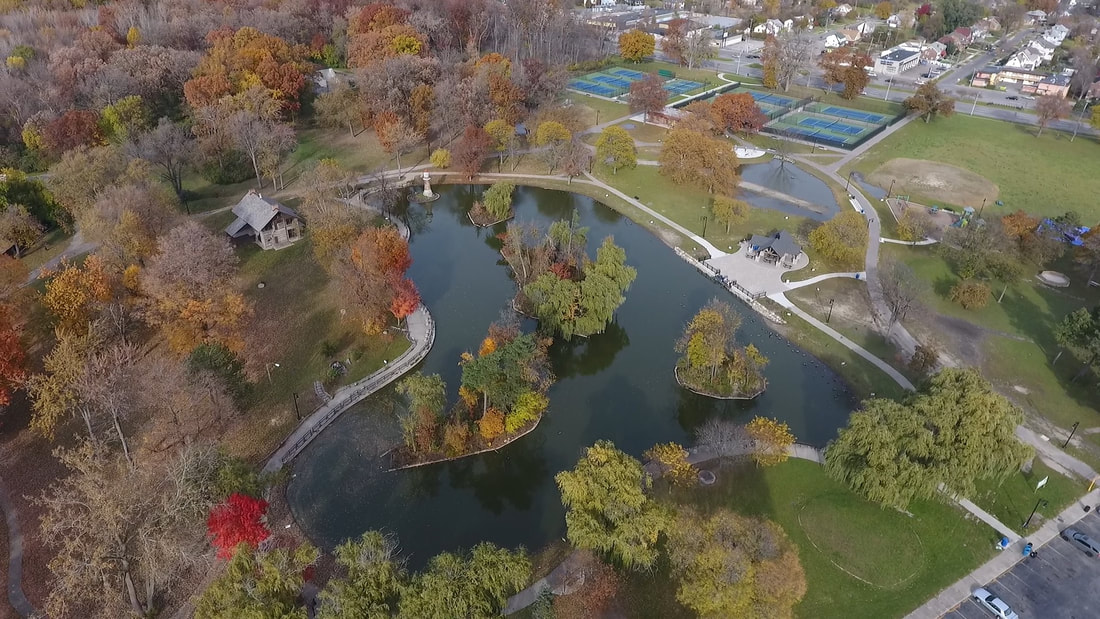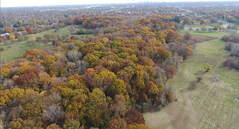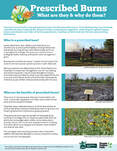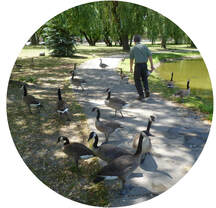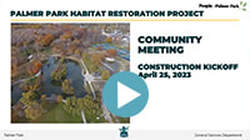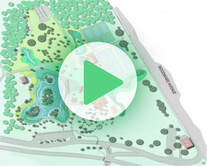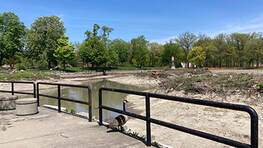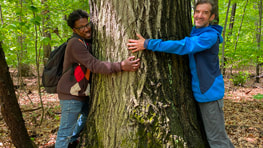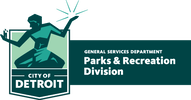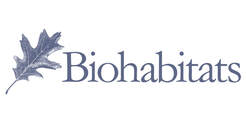|
ABOUT THE PARK
Palmer Park Habitat Restoration Project |
|
GET INVOLVED AND HAVE FUN LEARNING!
People for Palmer Park will be keeping you updated here on this page as each zone goes through its transformation throughout the seasons. Next up
What's going on in Palmer Park?
What happened to Lake Frances? Why is the grass so long? What's with all the orange fencing? The work you are seeing is years of careful planning being put into action!
|
Project Area
COMING HABITAT IMPROVEMENTS:
Follow us on Instagram! Explore photos and videos as the habitat evolves!
|
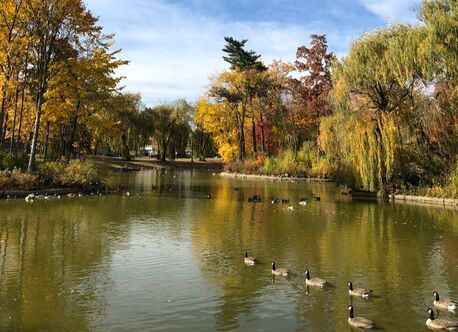
About Lake Frances
The roughly 3-acre lake was initially created as a recreational and scenic amenity for the park and is lined with a clay liner in order to hold water. The lake is fairly shallow, ranging from one foot to eight feet deep at the drain-down location towards the southern end. The water in the lake has very high levels of nutrients (as confirmed with water and sediment testing provided by University of Detroit-Mercy faculty and students) likely stemming from goose inputs, lack of water circulation, and sediment from runoff over time.
There are a series of small islands in the lake. Originally planted with ornamental trees and shrubs, they are currently densely overgrown, with some dead or dying vegetation, and very weedy. The vegetation shades out the ground plan and prevents healthy, naturalized plantings from growing. This leads to shoreline erosion, which is occurring in some locations.
The lake has a limited fish population, primarily carp, and attracts a large population of urban geese, which feed on the adjacent lawn as well as the nearby golf course within the park. They are also attracted by park patrons who feed them. The geese defecate on the adjacent walks and lawns, which makes it unpleasant for use and contributes nutrients and other pollutants to the lake.
Source: “Lake Frances Revitalization for Palmer Park” (October 2016) Prepared by Conservation Design Forum, Lombard, IL
The roughly 3-acre lake was initially created as a recreational and scenic amenity for the park and is lined with a clay liner in order to hold water. The lake is fairly shallow, ranging from one foot to eight feet deep at the drain-down location towards the southern end. The water in the lake has very high levels of nutrients (as confirmed with water and sediment testing provided by University of Detroit-Mercy faculty and students) likely stemming from goose inputs, lack of water circulation, and sediment from runoff over time.
There are a series of small islands in the lake. Originally planted with ornamental trees and shrubs, they are currently densely overgrown, with some dead or dying vegetation, and very weedy. The vegetation shades out the ground plan and prevents healthy, naturalized plantings from growing. This leads to shoreline erosion, which is occurring in some locations.
The lake has a limited fish population, primarily carp, and attracts a large population of urban geese, which feed on the adjacent lawn as well as the nearby golf course within the park. They are also attracted by park patrons who feed them. The geese defecate on the adjacent walks and lawns, which makes it unpleasant for use and contributes nutrients and other pollutants to the lake.
Source: “Lake Frances Revitalization for Palmer Park” (October 2016) Prepared by Conservation Design Forum, Lombard, IL
Past Project Milestones
|
VAULT CONSTRUCTION
DECEMBER 2023 The construction of a 10’ x 7’ vault component of the new filtration system has been completed on the south end of the lake near the parking lot. Here a pump will suck in water and push water out to the two filtration areas as the lake slowly returns to full. |
|
|
LAKE FRANCES ISLAND PLANTING
NOVEMBER 2023 Most of the vegetation was removed during the lake drain/dredge phase of the project since it was determined to be mostly invasive. PlantWise has now completed the replanting of the islands and has fenced off the area to protect it from deer and other wildlife until the plantings are established. This fencing around the lake may be up for a year or more as this happens. |
|
|
NEW LAKE FILTRATION SYSTEM
FALL TO WINTER 2023 This manmade lake was set up for draining with 2 settings: a lower winter setting and a higher one for warmer drier months. It will remain at one setting when we complete this project…for the health of the plants, to keep the water at a normalized level as much as possible which is best for the lake. Upon completion, the depth of the lake will be close to its original levels of 8-10 feet. Nature's filtration system In a natural lake or stream in an ecosystem, the cycle would look like water feeding into and out out the system, and plantings would occur on different levels (which can absorb excess nutrients and control edges, water circulation, etc) all having an ecological function as nature’s way of “keeping things clean." What is actually happening with our filtration system? In the cross section of lower stone material, different types of bacteria will attach to the stone and the roots of the plants and consume the excess nutrients in the water (primarily phosphorus and nitrogen which is the food source for algae). In other words, the water is kept cleaner when these excess nutrients are kept under control. Water is constantly circulating through and getting treated throughout the growing season. In winter plants “shut down”, but the bacteria does not, so this will help maintain a good water quality throughout the year. |
|
|
PRESCRIBED BURN
POSTED 5/11/2023 The City of Detroit in cooperation with the Fire Department and Huron Clinton Metroparks performed a prescribed burn this morning in the meadow behind the Detroit Exploration + Nature Center (The DEN) near Woodward and 7 Mile Rd. This burn was administered by professionals and is a part of our developing work to manage natural areas at the Palmer Park habitat. For additional insight and information into the prescribed burn process, download the FAQ sheet below.
|
Photos courtesy of the City of Detroit
| ||||||||
|
DRAIN AND DREDGE OF LAKE FRANCES
STARTED IN EARLY 2023 Draining and dredging of Lake Frances began in the early part of the year while there was still snow on the ground. 12-18" of dredged material was relocated into the grassy area south of the tennis courts so it could "de-water" through the warmer months. Testing was done to determine the final characterization of the dredging material and when it was deemed ecologically safe, the pile was grated, top dressed and seeded with a cover crop. This will provide expanded natural areas for improved ecology, storm water management and habitat for birds and pollinators. During this time, most of the invasive vegetation on the islands was removed and these areas will be naturalized and managed to provide better habitat for birds and pollinators, limit goose activity and support the improved ecology of the Lake. Island planting should be completed and fenced by the end of November 2023. |
|
|
ASH TREE RESEARCH INITIATIVE
POSTED 12/7/2021 Several Ash tree species are native to Michigan (White Ash, Green Ash, Blue Ash), and are valued for a number of qualities. Many were planted in parks and parkways to replace other tree species wiped out by disease, including the American Chestnut and the American Elm. The Emerald Ash Borer is an invasive insect that has killed many Ash tree species in Michigan (and much of the U.S.), including the Ash trees in Palmer Park. The Greening of Detroit has partnered with the USFS to test and research the viability of Emerald Ash Borer (EAB) resistant Ash Trees. Seeds of Ash trees known to have a high level of resistance to EAB have been germinated and raised into seedlings. Greening of Detroit has acquired 100 of these seedlings, and are planting them in several City of Detroit parks to test their ability to thrive in various settings. Palmer Park is one of the parks where these trees were planted. Twenty EAB-resistant seedlings were planted, and twenty non-resistant seedlings of the same age were also planted. Wire cages were placed over the trees to keep them from being eaten by deer or other animals. Palmer Park is an ideal location to test the trees, as it contains a remnant forest (Witherell Woods), a natural woodland that offers a broader range of test conditions than most typical park settings.The trees will be observed over the next several years, and the findings will be recorded and distributed to other researchers and agencies doing similar work. |
The research on EAB resistant Ash tree species will assist the continued advancement of strategies to protect, restore, and improve our urban tree canopy, especially in light of the increased challenges of rapidly changing climate, introduction of other new insect and diseases, and other threats.
Members of the City of Detroit's General Services Department, DEN, community stakeholders planting the resistant ash tree seedlings in Palmer Park.
|
|
ECOLOGICAL SITE WALK
POSTED 8/3/2021 Last week, Dr. Gerould Wilhelm led an on-site walk through Palmer Park to share his observations and suggested stewardship practices as we move forward with our restoration activities. Dr. Wilhelm is a nationally acclaimed botanist and ecologist, author, founding member of Conservation Research Institute and one of the ecological restoration experts on our Habitat Project Team. Participants were able to ask questions and gain a better understanding of the site ecology and botanical aspects of the habitat. Dr. Wilhelm shared his observations on the meadows of the park and of the forest growth—native and invasive—we know as Witherell Woods. It is a fascinating site walk and we encourage you to listen and learn more about the cultures and history that shaped it, and what we can learn from it to work toward naturalizing the habitat again. FULL AUDIO OF THE WALK (1 hour, 6 min) |
|
Community Update Meetings
|
Project Community Update #2
City of Detroit | April 25, 2023 Reintroduction of our project team, reviewing the project overview and timeline from 2012 to now, public survey information, collaboration and engagement, moving forward, review of survey poll questions, Q&A with community and next steps in the project. |
Project Community Update #1
City of Detroit | February 16, 2022 Meet the Project Team Partners, view first renderings of the intended outcomes of the restoration of the habitat, budget, projected timeline and how this relates to the People for Palmer Park Master Plan and the ongoing City improvements to the park. |
Media
|
Project aims to restore wildlife habitats at Palmer Park
WDET | Solina Robles | May 31, 2023 |
|
How you can get involved
For more information on partnering and volunteering with the Palmer Park Habitat Project, please contact:
Farhat Chaudhry, Project Manager / Designer
(313) 224-1100
[email protected]
For more information on joining our habitat steward work groups, please contact:
Kate Gmyrek, Assistant Chief of Landscape Architecture
(313) 920-7424
[email protected]
For more information on partnering and volunteering with the Palmer Park Habitat Project, please contact:
Farhat Chaudhry, Project Manager / Designer
(313) 224-1100
[email protected]
For more information on joining our habitat steward work groups, please contact:
Kate Gmyrek, Assistant Chief of Landscape Architecture
(313) 920-7424
[email protected]
|
Core project partners:
|

